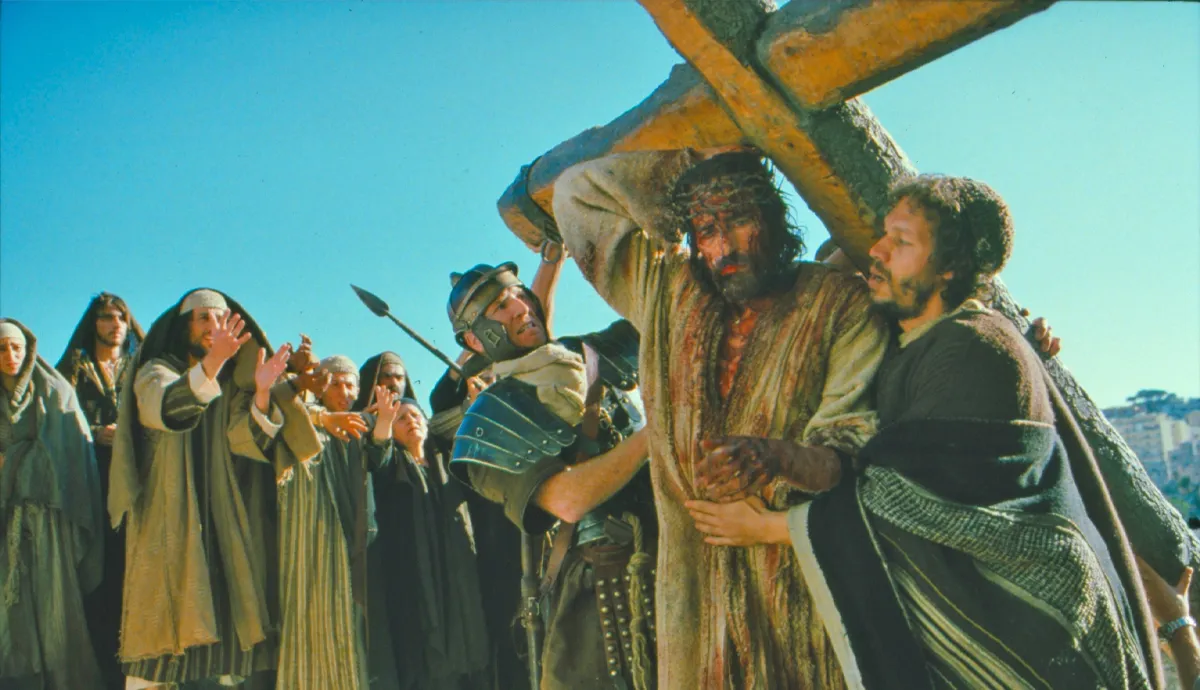The Passion of the Christ, directed by Mel Gibson and released in 2004, remains one of the most talked-about and controversial films in cinematic history. This epic biblical drama depicts the last 12 hours of Jesus Christ’s life, focusing on His crucifixion and the immense physical and spiritual suffering He endured. The film, lauded for its raw realism and criticized for its violent imagery, has sparked conversations about faith, sacrifice, and the power of storytelling.
In this comprehensive review, we’ll explore The Passion of the Christ, from its themes and production to its reception, cultural impact, and lasting legacy in the world of film and religion.
The Origins of The Passion of the Christ
Mel Gibson’s Vision
Mel Gibson, known primarily as an actor and for directing films like Braveheart, took on an ambitious project with The Passion of the Christ. Gibson’s motivation for creating the film stemmed from his deep Catholic faith and a desire to bring the story of Christ’s suffering and sacrifice to life. His goal was to create a film that would deeply resonate with both believers and non-believers, showing the humanity and divinity of Jesus Christ in His final hours.
Gibson financed the film himself, putting up an estimated $30 million of his own money to ensure creative control and freedom from studio influence. This decision allowed him to make the film as authentically and accurately as possible, using Aramaic, Latin, and Hebrew—the languages spoken in the time of Christ—to increase the historical realism.
Historical Context and Source Material
The Passion of the Christ is primarily based on the four canonical Gospels of the New Testament: Matthew, Mark, Luke, and John. However, it also draws inspiration from other religious texts and writings, including the accounts of Anne Catherine Emmerich, a German nun and mystic whose visions of Christ’s passion were documented in The Dolorous Passion of Our Lord Jesus Christ.
The film focuses on the last 12 hours of Jesus Christ’s life, starting with His agony in the Garden of Gethsemane and culminating in His crucifixion. It explores themes of betrayal, sacrifice, love, and redemption, and portrays the physical and emotional torment endured by Christ on His path to fulfilling His divine mission.
Themes in The Passion of the Christ
1. Suffering and Redemption
One of the most prominent themes in The Passion of the Christ is the immense suffering that Jesus endures for the redemption of humanity. The graphic depiction of His physical pain—from the brutal scourging to the crowning with thorns and ultimately the crucifixion—forces viewers to confront the magnitude of Christ’s sacrifice. This suffering is not just physical; it is deeply spiritual, as Jesus wrestles with the weight of humanity’s sins.
Gibson’s decision to depict the violence so vividly was intentional, aiming to convey the true extent of Christ’s love and sacrifice for mankind. The film leaves no room for ambiguity about the price paid for redemption, making it an emotionally intense and often difficult experience for viewers.
2. Faith and Betrayal
Another central theme in the film is the contrast between faith and betrayal. Judas Iscariot’s betrayal of Jesus, leading to His arrest and eventual crucifixion, plays a significant role in the narrative. Judas’ inner turmoil is palpable as he grapples with the consequences of his actions, and his story serves as a cautionary tale about the dangers of greed and disloyalty.
On the other hand, the faith of characters like Mary, the mother of Jesus, and John the Apostle, is portrayed as unwavering. Despite witnessing unimaginable suffering, their devotion to Jesus remains steadfast. This juxtaposition between faith and betrayal is a recurring element throughout the film, challenging viewers to reflect on their own beliefs and loyalties.
3. Love and Sacrifice
At its core, The Passion of the Christ is a story about love—both divine and human. Jesus’ willingness to endure excruciating pain for the salvation of humanity is the ultimate act of love and sacrifice. The film explores the depth of this love through Christ’s interactions with His disciples, His mother, and even His persecutors.
Throughout the movie, moments of tenderness are interspersed with the brutality, such as when Jesus reassures His mother that His suffering is necessary to fulfill His mission. These moments of love and compassion underscore the idea that Christ’s passion is not only about physical torment but also about a profound spiritual love that transcends suffering.
The Cinematic Experience
1. Visual Storytelling and Cinematography
One of the most striking aspects of The Passion of the Christ is its visual style. The cinematography, helmed by Caleb Deschanel, creates a visceral and immersive experience for the audience. The film’s color palette is dominated by dark, earthy tones, reflecting the gravity of the subject matter, while the lighting often emphasizes the contrast between light and darkness—both literally and metaphorically.
Close-up shots of Jesus’ face, bruised and bloodied, bring the viewer face-to-face with the intensity of His suffering. The camera lingers on these painful moments, forcing the audience to grapple with the physicality of the crucifixion. The film’s use of slow motion in key scenes, such as the nailing of Christ to the cross, heightens the emotional impact.
2. The Soundtrack
The score for The Passion of the Christ, composed by John Debney, adds another layer of emotional intensity to the film. The haunting, ethereal melodies combine with traditional Middle Eastern musical elements to create a soundtrack that enhances the film’s atmosphere of spiritual struggle and ultimate triumph. The music swells in moments of great tension and softens during scenes of reflection, guiding the audience through the emotional highs and lows of the story.
3. Authenticity and Language
One of the unique elements of The Passion of the Christ is its use of Aramaic, Latin, and Hebrew—the languages spoken during Jesus’ time. Gibson’s decision to use these ancient languages, with subtitles for modern audiences, adds a layer of authenticity to the film. This choice immerses viewers in the world of 1st-century Judea, enhancing the historical and cultural realism of the narrative.
Reception and Controversy
1. Box Office Success
Despite initial doubts from industry insiders, The Passion of the Christ was a massive box office success. The film grossed over $600 million worldwide, making it one of the highest-grossing R-rated films of all time. Its success was due in large part to its appeal to religious audiences, particularly Christian communities, who saw the film as a powerful depiction of their faith.
2. Criticism and Controversy
While The Passion of the Christ received praise for its technical achievements and emotional depth, it also sparked significant controversy. Some critics argued that the film’s graphic violence was excessive and unnecessary, accusing Gibson of sensationalizing the suffering of Christ. The film’s depiction of Jewish leaders, particularly in relation to Jesus’ crucifixion, also led to accusations of anti-Semitism, which Mel Gibson publicly denied.
In addition to its content, The Passion of the Christ faced scrutiny for its theological interpretations, with some arguing that it emphasized Christ’s physical suffering at the expense of His teachings and spiritual message. Nonetheless, the film sparked widespread discussion and debate, drawing attention to the story of Christ in a way that few other films had.
Legacy and Cultural Impact
1. Impact on Religious Films
The Passion of the Christ has had a lasting impact on the genre of religious films. Its commercial success demonstrated that there is a substantial audience for faith-based movies, prompting a resurgence in biblical and religious storytelling in Hollywood. Films such as Son of God and Risen followed in the footsteps of The Passion of the Christ, though none achieved the same level of cultural impact.
2. Spiritual and Cultural Conversations
The film’s intense portrayal of Christ’s suffering reignited discussions about the meaning of faith, sacrifice, and redemption, both within religious communities and in broader cultural circles. Viewers were prompted to reflect on their own beliefs, and many religious leaders used the film as a tool for evangelism and teaching.
3. Potential Sequel
In recent years, there have been rumors and discussions about a potential sequel to The Passion of the Christ, with Gibson himself mentioning plans for a follow-up film focusing on the resurrection of Jesus. While details remain scarce, the idea of a sequel has generated significant interest among religious and film communities alike.
Conclusion
The Passion of the Christ remains a powerful and polarizing film, revered by some for its portrayal of faith and sacrifice and criticized by others for its graphic violence and controversial themes. Regardless of one’s personal views, there is no denying the impact that the film has had on both religious cinema and popular culture.
Through its raw depiction of the final hours of Jesus Christ’s life, The Passion of the Christ challenges audiences to confront the physical and spiritual dimensions of Christ’s sacrifice. It stands as a testament to the power of film to evoke deep emotional and spiritual responses, making it a significant cultural and religious work that continues to resonate with audiences around the world.

